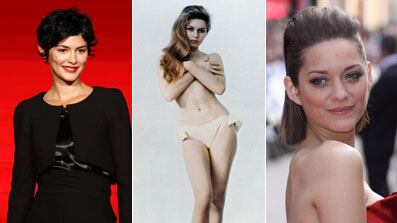France is a woman. It isn’t just that the nation is referred to as la France; the symbolic embodiment of the nation is a mythical lady named Marianne, a sort of unofficial patron saint who struggles for liberty, equality, and brotherliness. Oh, and she’s usually portrayed as being terrifically sexy.
Click Image to View Our Gallery of Women Bardot Inspired

Whenever Marianne appeared on statues, stamps, and currency for hundreds of years, the muse was either the artist’s imagination or some anonymous (and often topless) beauty. That changed in 1969, when the nation’s sexiest woman, Brigitte Bardot, was chosen as the first celebrity model for Marianne. It was a natural choice given that Bardot represented a young, vibrant, and rebellious France. Her rustic natural beauty combined with a shockingly unapologetic libido in her early films to propel a global myth about French beauty and sexuality that endures to this day. Back then the often-unclad Bardot’s underlying message might be summarized as: Follow me to the sexual revolution!
Bardot echoed her country in other ways. Her characters were often capricious and self-centered, not entirely unlike French leaders, who repeatedly insisted that France be allowed to play by different rules under the guise of the “French exception.” Bardot, who turns 75 on Monday, may have been a sexual icon—and sometimes mistaken for a feminist icon—but she hardly carved a path that most other women could follow. Who else had a derrière like the one that inspired a character in the 1956 film And God Created Woman to say, “Her ass is a song”?
• Gallery: Bardot Through the YearsFrance has been radically transformed since Bardot’s prime—especially in the last decade or so—and so has its feminine ideal. In a country where glass ceilings long prevented women from reaching the upper echelons of power and women only earned the right to vote during World War II, Socialist presidential candidate Ségolène Royal earned 47 percent of the vote in 2007. Nicolas Sarkozy, the man who defeated Royal, initially named seven women to his 15-member council of ministers, and elevated women well beyond the traditionally accepted “soft” ministry positions to heavyweight offices in justice, finance, and the interior. The head of France’s largest employer’s organization is female, as is the current Socialist Party leader. Women remain underrepresented in parliament, but there are now powerful female role models such as the Hillary Clintonesque Michèle Alliot-Marie, the former minister of defense and current minister of justice, or the competent and witty minister of the economy, Christine Lagarde, ranked by Forbes last month as the 17th most powerful woman in the world.
But outside of the corridors of power, it is true that women still face plenty of pressure to show their wares. Take France’s national women’s soccer team, which has long struggled to attract fans and secure a television deal (like the women’s teams of some other European countries). Several players recently posed topless to broaden the team’s fan base—and they’d never had so many interview requests!
As for the lovely symbols of France, they have evolved enormously since Bardot’s prime. The next Marianne, chosen in the late 1970s, was legendary actress Catherine Deneuve, with her grounded ice queen beauty and professional drive that saw her hone her acting skills in a way that Bardot never did.
Since then France’s beloved actresses have shown talent, breadth and depth that went far beyond Bardot, the perennial sex kitten. In the 1980s, Isabelle Adjani with her porcelain white skin, blue eyes and dark hair—the result of parents from Germany and Algeria—proved capable of playing innocence, duplicity, and vengefulness all in the same blockbuster film ( One Deadly Summer). France fell in love with actress Sophie Marceau, known in America as a Bond girl, in her coming-of-age film, La Boum, but the career of the ever classy and stunningly beautiful Marceau is flowing smoothly into her fourth decade. (In 2005 a breeze at Cannes exposed Marceau’s breast before the photographers’ line, literally stealing the breath of appreciative French television announcers.) Even now, Marceau is the preferred actress of 54 percent of French people.
Bardot hardly carved a path that most other women could follow. Who else had a derrière like the one that inspired the comment “Her ass is a song”?
There have been other demoiselles of France. Juliette Binoche was for a time France’s cute, spunky ingénue. Beatrice Dalle was its brief no-holds-barred incarnation of passion in Betty Blue. Singer and actress Vanessa Paradis, who is Johnny Depp’s partner, was France’s teenage crush in the ’80s, and she continues a thriving if eclectic career. The sumptuous Emmanuelle Béart entranced France in a two-part literary adaptation of a Marcel Pagnol novel about a girl so beautiful that men literally went crazy for her, and the fascination continues.
This decade has seen the rise of another breed of French actress ever more different from the Bardot model. Only a few retain a degree of overt sexuality, but it is not a dominant trait. There is the doe-eyed Marion Cotillard, who won an Oscar for her role as French singer Edith Piaf in La Vie en Rose, and the sweet, earthy Charlotte Gainsbourg, who appeared in 21 Grams, The Science of Sleep, and I’m Not There. Gainsbourg is beloved in France, although many French people cannot see her without remembering “Lemon Incest,” the incendiary duet that she performed as a young teenager with her provocateur father, Serge Gainsbourg, France’s cross between Jim Morrison and Bob Dylan. (Serge also did the duet “Bonnie and Clyde” with Bardot and “Dieu Est un Fumeur d’Havanes”—“God Smokes Havana Cigars”—with Catherine Deneuve.)
Globally, the biggest French actress abroad these days may be Audrey Tautou, the ingénue who became famous as Amelie, went Hollywood in The Da Vinci Code, and is now appearing in Coco Before Chanel. So what does the evolution of the nation’s starlets say about France today? Well, the selection process for Mariannes was changed in 1999, and all 36,000 mayors were permitted to vote for the model. They overwhelmingly chose the supermodel (and now actress) Laetitia Casta, a fleshy woman-child with deliciously crooked teeth. In contrast to the young Bardot a half century earlier, Casta claimed chastity until she was in her late teens, saying that she was looking for Mr. Right.
The statue of Casta/Marianne is still topless, of course. And the progress since then? A smaller group of mayors next picked an afternoon talk-show host, Evelyne Thomas, in a controversial decision. Thomas, who made her name with simplistic, housewife-friendly broadcasts, is competent and talkative, but the sexiness quotient? Not much. Say it ain’t so, Brigitte Bardot.
Eric Pape has reported on Europe and the Mediterranean region for Newsweek since 2003. He is co-author of the graphic novel, Shake Girl, which was inspired by one of his articles. He has written for the Los Angeles Times magazine, Spin, Vibe, Le Courrier International, Salon, Los Angeles and others. He is based in Paris.





